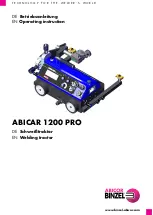
INST
ALLA
TION
13
Discharge Pipework
It is a requirement of Building Regulations that any discharge from an unvented system is conveyed to where it is visible,
but will not cause danger to persons in or about the building. The tundish and discharge pipes should be fitted in accordance
with the requirements and guidance notes of Building Regulations. Building Regulation G3 Requirements and Guidance are
reproduced in the following sections.
For discharge pipe arrangements not covered by G3 Guidance advice should be sought from your local Building Control
Officer. Any discharge pipe connected to the pressure relief devices (Expansion Valve and Temperature / Pressure Relief Valve)
must be installed in a continuously downward direction and in a frost free environment.
The water may drip from the discharge pipe of the pressure relief device and that this pipe must be left open to the
atmosphere. The pressure relief device is to be operated regularly to remove lime deposits and to verify that it is not blocked.
G3 Requirement
“...there shall be precautions...to ensure that the hot water discharged from safety devices is safely conveyed to where it is
visible but will not cause danger to persons in or about the building”.
Notes:
1) Discharge pipe-work D2 can now be a plastic pipe but only pipes that have been tested to a minimum 110°C must be used.
2) Discharge pipe D2 can now be plumbed into the soil stack but only soil stacks that can handle temperatures of 99°C or
greater for prolonged periods should be used.
Worked example of discharge pipe sizing
This example is for a G½ temperature relief valve with a discharge pipe (D2) having 4 No. elbows and length of 7m from the
tundish to the point of discharge.
From Table 5:
Maximum resistance allowed for a straight length of 22mm copper discharge pipe (D2) from a G½ temperature relief valve is
9m.
Subtract the resistance for 4 No. 22mm elbows at 0.8m each = 3.2m
Therefore the permitted length equates to: 5.8m
5.8m is less than the actual length of 7m therefore calculate the next largest size.
Maximum resistance allowed for a straight length of 28mm pipe (D2) from a G½ temperature relief valve equates to 18m.
Subtract the resistance of 4 No. 28mm elbows at 1m each = 4m
Therefore the maximum permitted length equates to: 14m
As the actual length is 7m, a 28mm (D2) copper pipe will be satisfactory.
Table 5
Valve
outlet
size
Minimum
size of
discharge
pipe D1
Minimum size of
discharge pipe
D2 from tundish
Maximum resistance
allowed, expressed
as a length of straight
pipe (i.e. no elbows
or bends)
Resistance
created
by each
elbow
G ½
15mm
22mm
28mm
35mm
Up to 9m
Up to 18m
Up to 27m
0.8m
1.0m
1.4m
G ¾
22mm
28mm
35mm
42mm
Up to 9m
Up to 18m
Up to 27m
1.0m
1.4m
1.7m
G 1
28mm
35mm
42mm
54mm
Up to 9m
Up to 18m
Up to 27m
1.4m
1.7m
2.3m
Safety device
(e.g. Temperature relief valve)
600mm
max.
Metal discharge pipe (D1) from
Temperature relief valve to tundish
300mm
min.
Discharge pipe (D2) from tundish with
continuous fall. See Building Regulation G3
section 3.56, Table 4 and worked example.
Trapped gully
Discharge below
fixed grating
(Building Regulation
G3 section 3.61 gives
alternative points
of discharge
Figure 9
Содержание Eco SolaReady
Страница 1: ...Hot Water Cylinders MEGAFLO Eco SolaReady Unvented MEGAFLO Eco SolaReady Product Guide...
Страница 48: ...SERVICING 48...
Страница 50: ...SERVICING 50...
Страница 51: ...SERVICING 51 Notes...














































